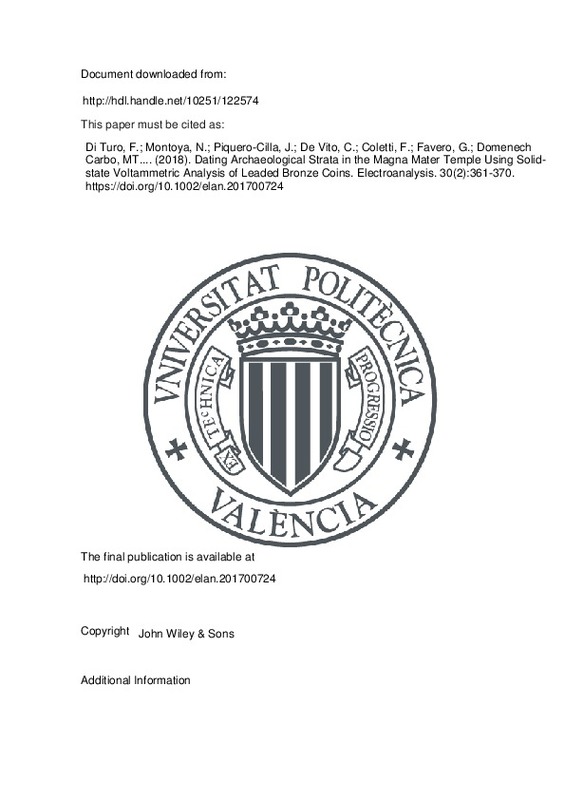JavaScript is disabled for your browser. Some features of this site may not work without it.
Buscar en RiuNet
Listar
Mi cuenta
Estadísticas
Ayuda RiuNet
Admin. UPV
Dating Archaeological Strata in the Magna Mater Temple Using Solid-state Voltammetric Analysis of Leaded Bronze Coins
Mostrar el registro sencillo del ítem
Ficheros en el ítem
| dc.contributor.author | Di Turo, Francesca
|
es_ES |
| dc.contributor.author | Montoya, Noemí
|
es_ES |
| dc.contributor.author | Piquero-Cilla, Juan
|
es_ES |
| dc.contributor.author | de Vito, Caterina
|
es_ES |
| dc.contributor.author | Coletti, Fulvio
|
es_ES |
| dc.contributor.author | Favero, Gabriele
|
es_ES |
| dc.contributor.author | Domenech Carbo, Mª Teresa
|
es_ES |
| dc.contributor.author | Doménech Carbó, Antonio
|
es_ES |
| dc.date.accessioned | 2019-06-24T20:00:43Z | |
| dc.date.available | 2019-06-24T20:00:43Z | |
| dc.date.issued | 2018 | es_ES |
| dc.identifier.issn | 1040-0397 | es_ES |
| dc.identifier.uri | http://hdl.handle.net/10251/122574 | |
| dc.description.abstract | [EN] The application of solid state electrochemistry techniques for dating archaeological strata using lead-containing bronze coins is described. The proposed methodology was applied to samples coming from the Roman archaeological site of Magna Mater Temple (Rome, Italy) occurring in different strata dating back between the second half and the end of the 4(th) century A.D. and the 20(th) century. The voltammetric signatures of copper and lead corrosion products in contact with aqueous acetate buffer, as well as the catalytic effects produced on the hydrogen evolution reaction, were used for establishing the age of different strata and dating coins belonging to unknown age. Voltammetric data were consistent with a theoretical approximation based on a potential rate law for the corrosion process. | es_ES |
| dc.description.sponsorship | Financial support from the MINECO Projects CTQ2014-53736-C3-1-P and CTQ2014-53736-C3-2-P which are supported with ERDF funds is gratefully acknowledged. PhD grants of the Department of Earth Sciences, Sapienza University of Rome, are gratefully thanked. | es_ES |
| dc.language | Inglés | es_ES |
| dc.publisher | John Wiley & Sons | es_ES |
| dc.relation.ispartof | Electroanalysis | es_ES |
| dc.rights | Reserva de todos los derechos | es_ES |
| dc.subject | Archaeology | es_ES |
| dc.subject | Dating, Roman coins | es_ES |
| dc.subject | Voltammetry of microparticles | es_ES |
| dc.subject | Bronze | es_ES |
| dc.subject | Lead | es_ES |
| dc.subject.classification | PINTURA | es_ES |
| dc.title | Dating Archaeological Strata in the Magna Mater Temple Using Solid-state Voltammetric Analysis of Leaded Bronze Coins | es_ES |
| dc.type | Artículo | es_ES |
| dc.identifier.doi | 10.1002/elan.201700724 | es_ES |
| dc.relation.projectID | info:eu-repo/grantAgreement/MINECO//CTQ2014-53736-C3-1-P/ES/APLICACION DE LAS TECNICAS NANOELECTROQUIMICAS Y BIOTECNOLOGIAS EN EL ESTUDIO Y CONSERVACION DEL PATRIMONIO EN METAL/ | es_ES |
| dc.rights.accessRights | Abierto | es_ES |
| dc.contributor.affiliation | Universitat Politècnica de València. Departamento de Conservación y Restauración de Bienes Culturales - Departament de Conservació i Restauració de Béns Culturals | es_ES |
| dc.description.bibliographicCitation | Di Turo, F.; Montoya, N.; Piquero-Cilla, J.; De Vito, C.; Coletti, F.; Favero, G.; Domenech Carbo, MT.... (2018). Dating Archaeological Strata in the Magna Mater Temple Using Solid-state Voltammetric Analysis of Leaded Bronze Coins. Electroanalysis. 30(2):361-370. https://doi.org/10.1002/elan.201700724 | es_ES |
| dc.description.accrualMethod | S | es_ES |
| dc.relation.publisherversion | http://doi.org/10.1002/elan.201700724 | es_ES |
| dc.description.upvformatpinicio | 361 | es_ES |
| dc.description.upvformatpfin | 370 | es_ES |
| dc.type.version | info:eu-repo/semantics/publishedVersion | es_ES |
| dc.description.volume | 30 | es_ES |
| dc.description.issue | 2 | es_ES |
| dc.relation.pasarela | S\358200 | es_ES |
| dc.contributor.funder | Ministerio de Economía, Industria y Competitividad | es_ES |







![[Cerrado]](/themes/UPV/images/candado.png)

